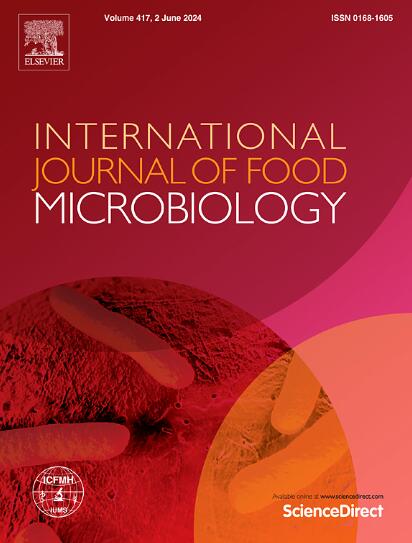一种常见食用鱼类——刺鱼科刺鱼(Saurida tumbil)寄生虫的人畜共患和生态意义:综述和原始研究的见解
IF 5
1区 农林科学
Q1 FOOD SCIENCE & TECHNOLOGY
International journal of food microbiology
Pub Date : 2025-06-18
DOI:10.1016/j.ijfoodmicro.2025.111324
引用次数: 0
摘要
沙乌达是一种具有商业价值的鱼类,分布在非洲、亚洲和大洋洲的36个国家和岛屿上。它是许多沿海社区的重要食物资源,因此鉴定和评估其寄生生物群对食品安全和生态监测具有重要意义。在本研究中,采用形态学和分子方法检测了从当地鱼市获得的140份瘤胃链球菌食源性寄生虫。从33条受感染的鱼身上共采集到123条线虫,均为活线虫。我们还对以前与这种鱼类有关的寄生虫进行了广泛的审查。基于对鱼类的研究和文献综述,我们的发现表明,瘤胃S.携带多种寄生虫,如原生动物、线虫和绦虫,其中一些具有潜在的人畜共患风险。关键的发现包括首次鉴定出异尖线虫III型幼虫为短刺棘虫,以及证据表明异尖线虫I型幼虫由两个遗传上不同的物种组成,尽管表现出更大的遗传差异,但在GenBank中都被标记为典型棘虫。异尖线虫是一种已知的海产寄生虫。此外,在文献中,另一种寄生虫,锥虫绦虫幼虫,在这种鱼中很常见。虽然人类感染锥虫幼虫是罕见的,但与八角虫相似,它们会引起过敏反应,并降低鱼类的销路,因为消费者对鱼肉中寄生虫的存在产生厌恶。我们的研究结果还强调了GenBank中错误标记序列所带来的挑战,这使得寄生虫幼虫的准确鉴定变得复杂。这些不准确妨碍了物种一级的鉴定,模糊了这些寄生虫的真正多样性和人畜共患的潜力,并最终阻碍了有效的监测和公共卫生反应。我们的研究结果有助于更好地了解沙蚤作为多种寄生虫宿主的作用,具有生态和人畜共患意义。本文章由计算机程序翻译,如有差异,请以英文原文为准。
Zoonotic and ecological implications of parasites in a popular edible fish, Saurida tumbil (Family Synodontidae): Insights from review and original research
Saurida tumbil, is a commercially valuable fish which is found in 36 countries and islands across Africa, Asia, and Oceania. It serves as a key food resource for many coastal communities, making the identification and assessment of its parasitic biota important for food safety and ecological monitoring. In this study, 140 specimens of S. tumbil, obtained from local fish markets were examined for foodborne parasites using both morphological and molecular approaches. A total of 123 nematodes, all alive, were collected from 33 infected fish. We also conducted an extensive review of parasites previously associated with this fish species. Our findings based on the examination of fish and the literature review reveal that S. tumbil hosts a diverse range of parasites, such as protozoans, nematodes, and tapeworms, several of which present potential zoonotic risks. Key discoveries include the first identification of Anisakis larval type III as A. brevispiculata, as well as evidence that Anisakis larval type I consists of two genetically distinct species, both labelled as A. typica in GenBank despite exhibiting greater genetic divergence. Anisakis nematodes are a known seafood borne parasites. Additionally in the literature, another parasite, trypanorhynch tapeworm larvae, were commonly found in this fish. Although human infections with trypanorhynch larvae are rare, similar to anisakids they can cause allergic reactions and reduce the marketability of fish due to consumer aversion caused by presence of parasites in fish flesh. Our results also highlight the challenges posed by mislabelled sequences in GenBank, which complicate the accurate identification of parasite larvae. These inaccuracies impede species-level identification, obscure the true diversity and zoonotic potential of these parasites, and ultimately hinder effective monitoring and public health responses. Our results contribute to a better understanding of Saurida tumbil's role as a host for diverse parasite species with both ecological and zoonotic significance.
求助全文
通过发布文献求助,成功后即可免费获取论文全文。
去求助
来源期刊
CiteScore
10.40
自引率
5.60%
发文量
322
审稿时长
65 days
期刊介绍:
The International Journal of Food Microbiology publishes papers dealing with all aspects of food microbiology. Articles must present information that is novel, has high impact and interest, and is of high scientific quality. They should provide scientific or technological advancement in the specific field of interest of the journal and enhance its strong international reputation. Preliminary or confirmatory results as well as contributions not strictly related to food microbiology will not be considered for publication.

 求助内容:
求助内容: 应助结果提醒方式:
应助结果提醒方式:


